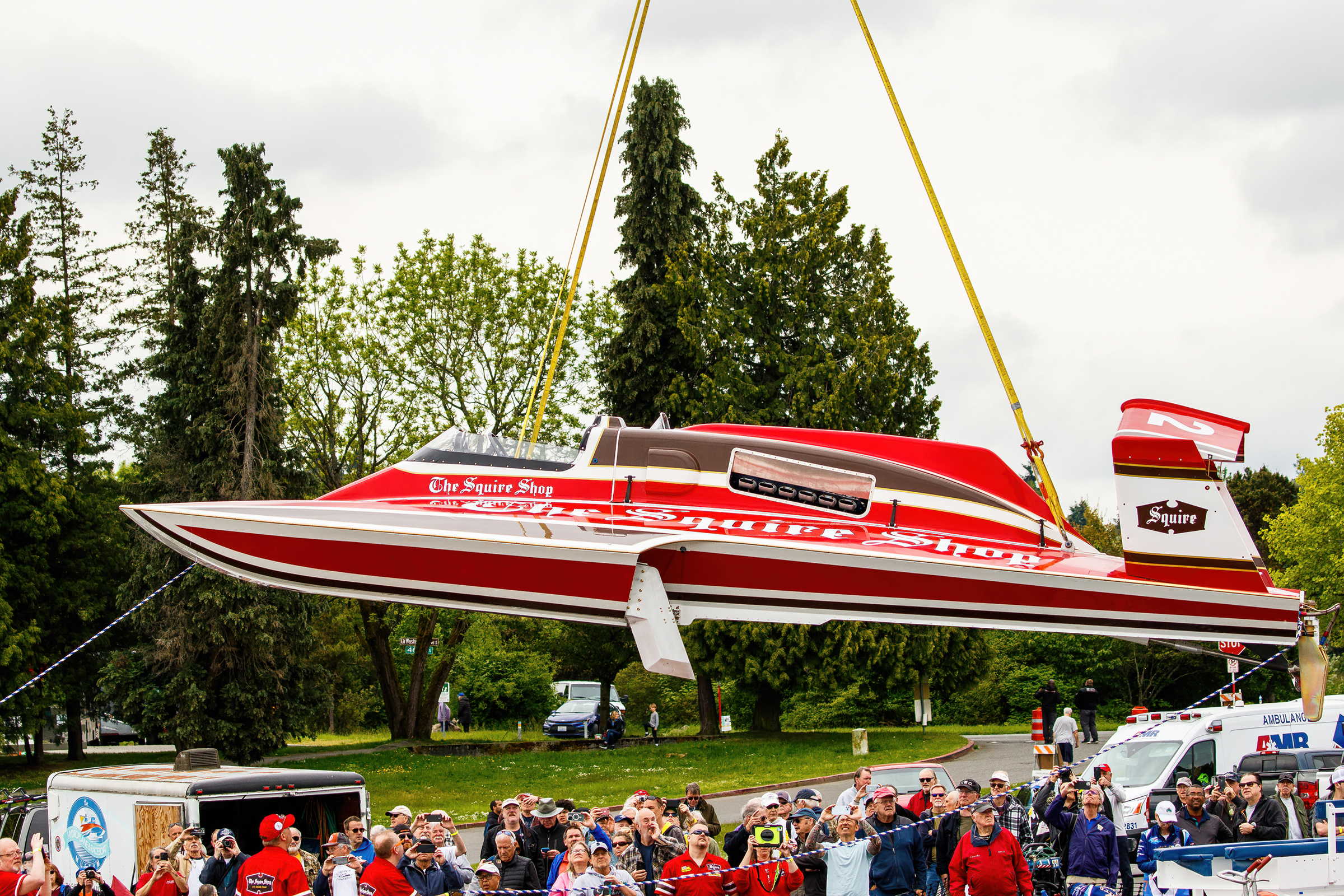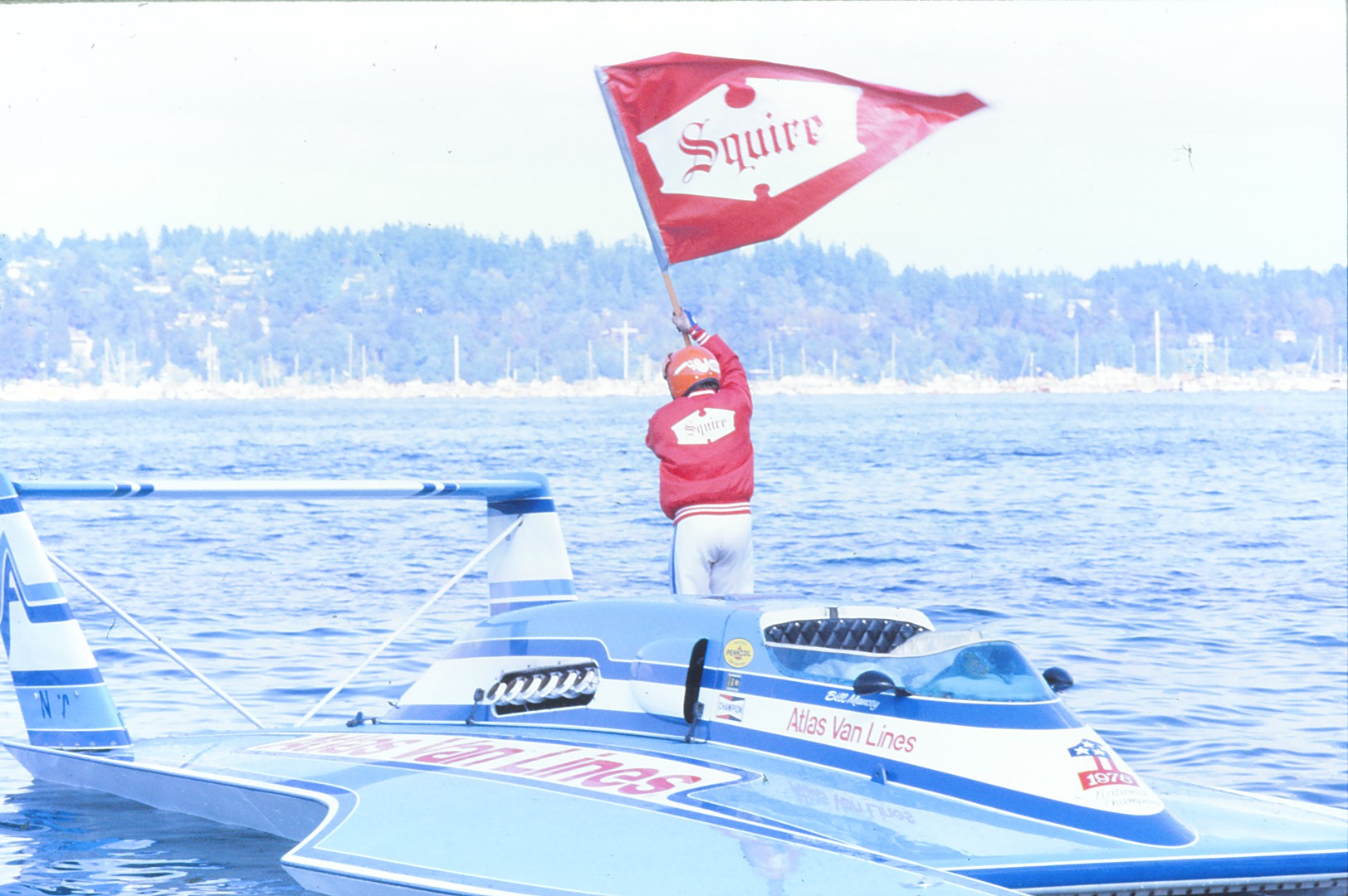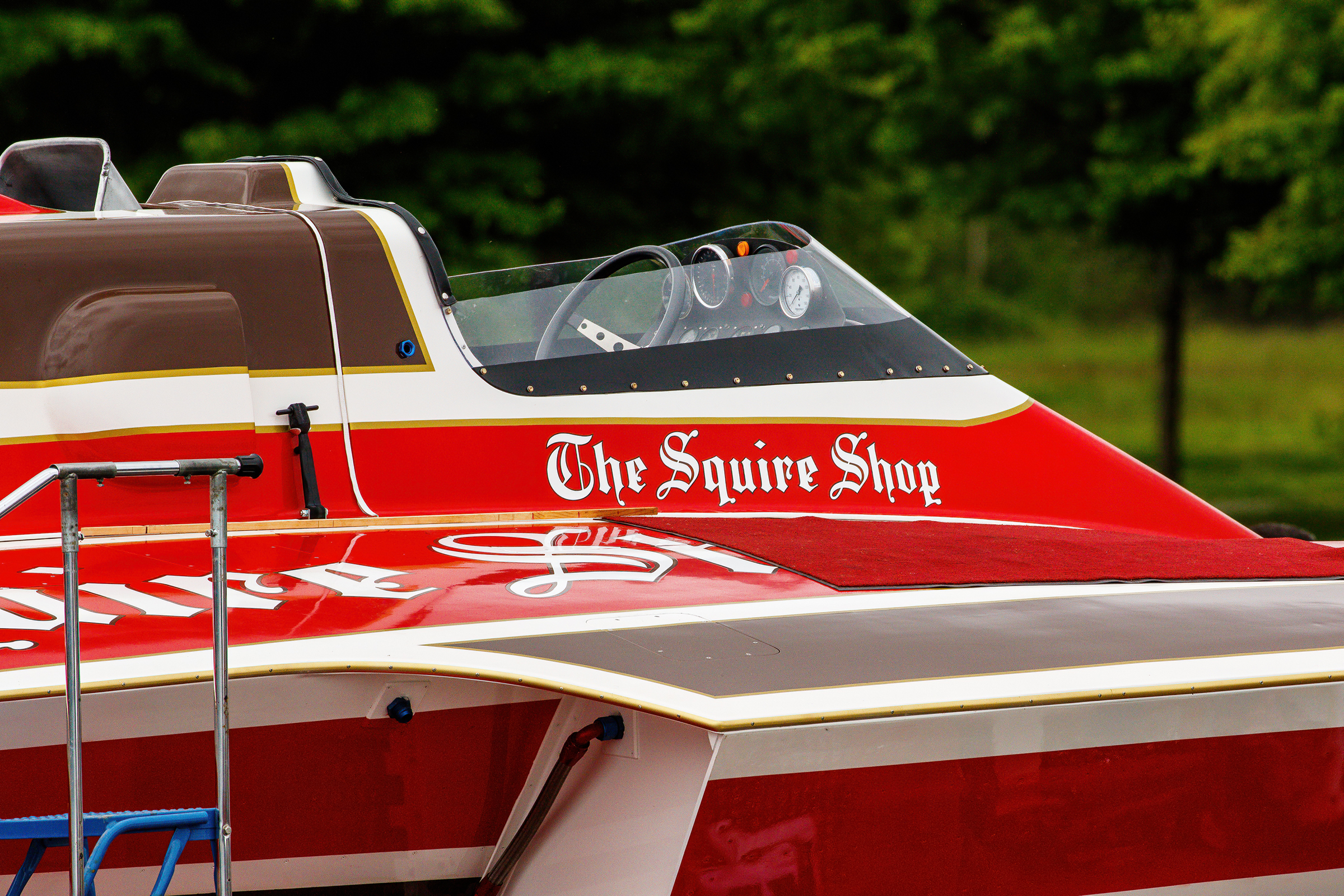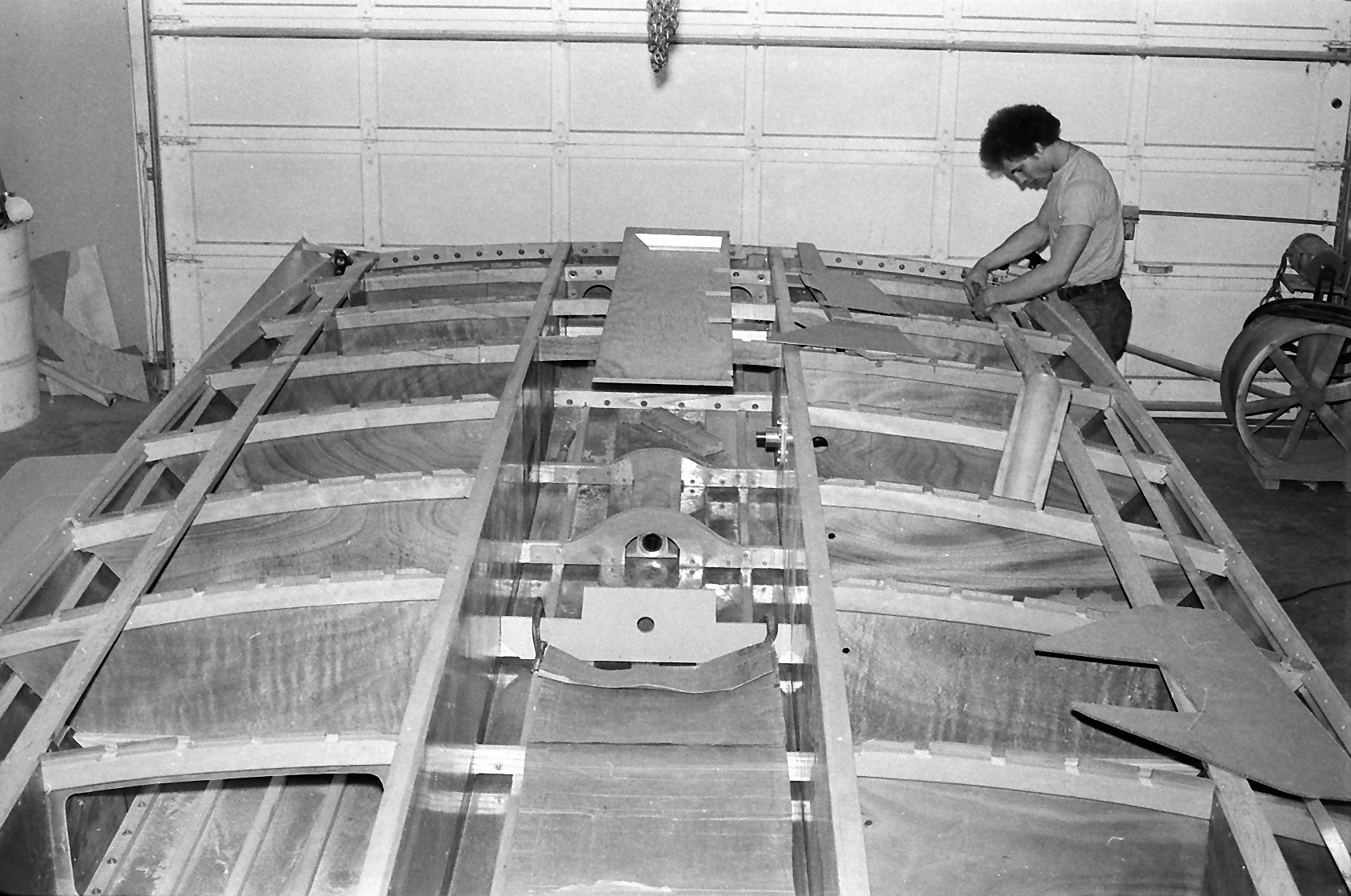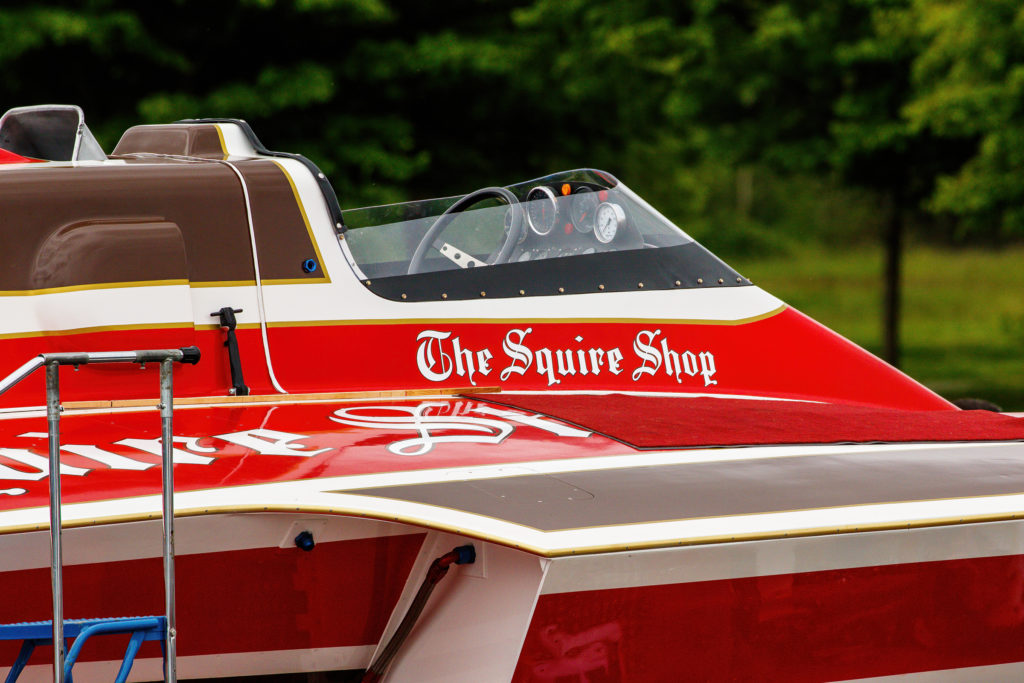
At many museums, the artifacts, art works, and other curiosities are displayed at arm’s length, preserved and protected in a glass case only for viewing. Not so at the Hydroplane & Powerboat Museum in Kent. Each and every hydroplane on display within the 12,000-square-foot space has been lovingly and painstakingly restored to run at its full, heart throbbing, adrenaline pumping potential of 150-200 miles per hour.
“Our mission is to celebrate, preserve, and honor the history of professional powerboat racing,” explains longtime executive director David Williams. “And if they just look at one, static in a museum, people don’t really get a sense of what a powerboat really is and how it works. But, to see it in action, flying across the water in motion, you’ll get goose bumps. You’ll understand the raw emotional power. That’s why we run our boats anywhere and everywhere they’ll let us.”
Since its inception in 1983, the museum has restored dozens of hydroplanes in its boat shop, including seven of the most famous Gold Cup and Harmsworth winners dating back almost seven decades. They loom large in racing lore: There’s the Miss America VIII (1929 and ‘31 Harmsworth winner); Slo-mo-shun IV (1950, ‘52, and ‘53 Gold Cup winner); Slo-mo-shun V (1951 and ‘54 Gold Cup winner); a Hawaii Kai III replica (1958 Gold Cup winner); Miss Thriftway (1961 and ‘62 Gold Cup winner); the legendary Green Dragon Miss Bardahl; and the 1967 Miss Budweiser.
Now, after an extensive, five-year-long restoration effort, the museum is set to reveal and re-christen another classic: The 1979 Squire Shop Unlimited Hydroplane.
Originally designed by Dave Knowlen and built by Norm Berg, this was the boat that carried renowned local driver Lee Edward “Chip” Hanauer to his very first Unlimited victory in ‘79. In a full circle moment, the 68-year-old Hanauer plans to climb back in the cockpit once again as Squire Shop runs on Lake Washington at this month’s Seafair—another Seattle institution making a triumphant return after a pandemic-induced hiatus.
The Squire Shop name itself smacks of Seattle nostalgia.
She’s named for a much beloved, locally established men’s clothing store, the sort of 1970s shop that shelled out Levi’s and bell-bottoms, leather jackets, and local racing paraphernalia. It also speaks to an era when hydros reigned supreme in the Emerald City. Before the Kraken, Sounders, Mariners and even the Seahawks arrived, hydro racing was the sport in town. Imagine the roar of the mammoth engines, the spray rocketing towards the blue skies as racers careened around a hairpin turn, the tourists and locals alike that flocked to every bit of spit of shoreline on Lake Washington to watch—it was all intrinsically tied to the Emerald City’s identity.
“This boat is so emblematic of the city itself,” reflects Hanauer. “It is so much a part of the history and legacy of the city; you can’t separate out Seattle from its ties to racing and boating and maritime. It’s the very fabric of who we are.”
As the moniker might suggest, the boat was originally owned by the clothing store’s popular proprietor, Bob Stiles. Stiles hired Hanauer to drive the hydro in 1978 after driver Jerry Bangs tragically died in an accident during the 1977 edition of Seafair and the boat had to be rebuilt. Hanuer stayed at the helm through the 1981 season, moving on to drive for other teams in what would be a decorated 20-year career on the water. But he still speaks highly and warmly of the man who gave him his shot. “He loved Seattle, and he loved Seafair,” Hanauer recalls. “So much so that one year [in 1978], he not only sponsored a boat, but stepped up to sponsor the entire race because it wasn’t going to happen due to lack of funds. Squire Shop didn’t make the final heat, but another driver, the renowned Bill Muncey and his team, all wore Squire Shop jackets as a tribute in that last race. I don’t think it’s an overstatement to say he saved Seafair.”
Squire Shop continued to race all the way until 2002 under a variety of owners and other names. (Her aliases included Miss Kyyx, Miss CKLW, Miss Raben Tire, Rampage III, Miss BECO, and Oh Boy! Oberto.) From there, she passed hands several times and fell off the radar until a racing fan by the name of Brad Haskin stumbled on a sales listing on eBay for the Squire in 2012. He alerted a fellow fan and Seattle friend Gary Laws, who purchased her and then later donated the hull to the museum for restoration.
There wasn’t much of a hull left. The wood frame was deteriorated and dilapidated, the electrical was shot, and pretty much every fitting, hose, and bracket from tip to tail needed to be replaced. At the museum, Williams knew he needed someone with expertise to lead the herculean project. He needed John Watkins.
A former hydro racer himself, Watkins had worked for Norm Berg in 1978 and ‘79 and had been one the original builders of Squire Shop. A mutual friend knew of his involvement then and recommended the museum ask him to lend his expertise as a project supervisor. Recently retired from a long career at Boeing, Watkins was intrigued by the restoration effort, and the potential for a retirement project. “I remember thinking I had this big shop at home that was just going to go to waste now that I was retired. Guess I needn’t have worried, the Squire Shop was just waiting for me,” he says, with a chuckle, reflecting on how the couple-of-days-a-week commitment became a five-year-long journey.
It turned out there was little left to save outside of a few scraps and the crew began to rebuild the Squire in 2016. Delays were inevitable, with the time it took to finagle fixes, track down parts (including dredging up an original cowling from the bottom of Lake Washington), and make extensive repairs, plus there was an almost year-and-half delay when she just sat in the shuttered shop during the Covid shutdowns. They ticked off the milestones though, one by one: There was the day they slid the framing on. Then, the decks went on. Watkins likens unveiling the paint job to that of Christmas morning anticipation. “You peel off all the tape and suddenly instead of a plain white boat, there emerges that bright signature red hull. And I thought, ‘Oh, there’s the Squire Shop.’”
It was the very definition of a labor of love. Outside of Williams and a few other employees who help with fundraising efforts, the museum and the boat shop are staffed entirely by volunteers. Watkins acted both as supervisor and mentor, passing along his extensive knowledge to the volunteer crew members and helping them to gain new skills as they make repairs.
“Some people are former racers or longtime fans or some are entirely new to the sport and just want to learn,” says Watkins. “But the educational piece of the restoration is really what makes it distinct.” He points to the dedication among the team in making this effort, and every other project at the museum, a success: “We literally have guys who come in twice a week to sweep and prep the shop. And they do it to be a part of the team, to get to wear a crew shirt come race day. They do it because they love it.”
Hanauer agrees. When he would swing by the museum to check on the repairs, he was awed by the convivial atmosphere in the shop: “In two words, I think it is rare and it is unique. The museum is a wonderful place that is driven by passion. In a world where sometimes the sense of community seems lost, it is alive and well here. The people care about each other, they have a common bond, and they work extremely hard.”
Beyond the museum, Squire Shop gained an online following after Laws, who donated the Squire Shop remains, created both a blog and a Facebook page to track the progress. Many fans logged on to share memories of her glory days, others asked questions of the experts, and still others came forward to donate their own memorabilia and even scraps from older iterations.
Finally, everyone circled May 24, 2022, on their calendars as the eagerly anticipated and long awaited date that the completed Squire Shop would take to the water once again for a test run on Lake Washington. That day, they put her through her paces, made notes on some adjustments, and now—finally—she’s ready to return to racing after her Seafair christening on August 5.
And while much of her fabrication is shiny and new, Watkins and the team have made sure to preserve her heart and history, too. They took every salvageable scrap of original wood they could find and created plaques that are now screwed into the interior frame of the hull. They are stamped with the names of the principal people involved in her story: the original designer; the first build team; the drivers who drove her to fame; and John Watkins, who had a hand in building her not once, but twice. “Now it’s like everyone from Squire Shop’s backstory is out running alongside us in the future, too,” he says.
The May run drew in curious onlookers as well as some new fans garnered from the online buzz who came out to see what the sport was all about. This fact encourages Hanauer, who hopes this year’s Seafair will help ignite a fire in a new generation of race fans. “My heart is warmed by the sense of camaraderie, of shared passion I’ve witnessed among this museum community. But I think we need to help newcomers understand the role that racing and Seafair play, and everything that maritime means to this city. Seafair can act as a catalyst to draw people in. Once they see it, they’ll want to experience for themselves, I think,” he muses.
But, for many the project has simply fanned a flame that never died out.
“It’s been a dream for a lot of us for a really long time to see this come to fruition,” concludes Williams. “I can’t say enough about the team that made it happen. They did it for the love of the sport and for the chance to stand on the lakeshore with their kid at Seafair and proudly say: ‘Yeah, I built that.’”
>> See the Squire Shop hydro in person at her August 5th christening at Seafair, or make plans to visit the Hydroplane & Powerboat Racing Museum; for details and further information, go to: thunderboats.ning.com. And, for a more extensive look at the restoration project, visit: 79squireshop.weebly.com.
